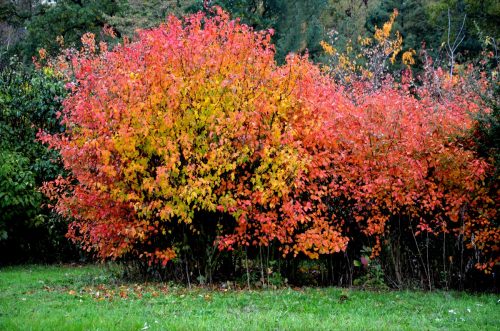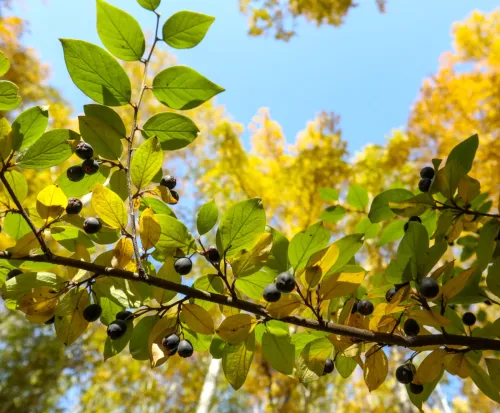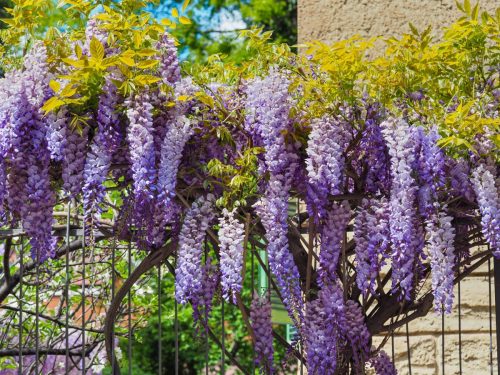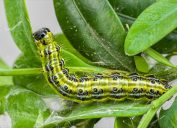5 Invasive Trees You Need to Remove From Your Yard Immediately
These trees can pose a threat to surrounding wildlife, not to mention your home.

A well-landscaped yard is an investment. It takes time to cultivate and maintain—and once you're happy with the look, chances are you don't want to start removing things. But certain trees can actually threaten surrounding wildlife and wreak havoc on your home. With that in mind, expert say that if you have invasive trees in your yard, you need to remove them immediately.
"Invasive trees are those species of trees which have been introduced to an area and are capable of outcompeting native species for resources and growing rapidly, potentially leading to detrimental effects on the environment," Zeeshan Haider, CEO and founder of Greenry Enthusiast, tells Best Life. "Many of these trees have already been widely introduced, and some have become a nuisance in residential areas. If you have these types of trees in your yard, it is important to identify and remove them to prevent further spread of the species."
Depending on the type of tree you have in your yard, there are different steps you'll need to take, and Charles van Rees, PhD, conservation scientist, naturalist, and founder of the Gulo in Nature blog, says that it might require some extra help. "If the tree is particularly large such that removal might be hazardous, it's worth calling a professional," he tells Best Life. You'll also need to plant a replacement, as invasive trees "may be quick to reclaim the space by deposited seeds or by a resilient rootstock," van Rees explains.
But before you get ahead of yourself and contact removal services, check to see if any of the following plants are in your yard (and confirm your IDs with an outdoor app). Read on to find out which five invasive trees you'll need to clear out.
READ THIS NEXT: If You Have This Common Tree in Your Yard, Prepare to Cut It Down, Officials Say.
1
Norway Maple

This perennial tree isn't native to the U.S., originating in Norway, as the name suggests. It generally grows to be between 40 to 60 feet tall, but can sometimes reach over 90 feet, according to the Minnesota Department of Agriculture (MDA). If this tree is in your yard, it's probably one you enjoy thanks to its vibrant color and the ample shade it provides. However, looks can be deceiving, as that extra shade makes it more difficult for grass and other plants to grow.
"Norway maple is the main attraction in autumn," Silvia Borges, gardening expert, and owner and chief editor of EnviroMom, says. "Its golden treetop lures many couples and newlyweds for photo sessions, but it's a big no-no having it in your garden." This massive tree has shallow roots and can also be dangerous in a storm, because "it's infamous for causing a lot of damage during strong winds."
Van Rees says that the Norway maple spreads easily when its seeds are dispersed by the wind. "If you let them thrive on your property, they'll cause issues for your neighbors and be quick to find a foothold in other parts of your space," he explains.
Seedlings can be removed by hand, but when they're bigger, you might have to dig up roots or cut down the tree, according to the MDA. Chemical treatments can then be used to help keep the Norway maple under control, but the New York Invasive Species Information website says that you should contact your local officials before doing so.
2
Amur Maple

Another invasive tree that could be in your yard is the Amur maple. You can identify this tree by its green leaves that turn golden and scarlet in the fall, sprouting pale yellow flowers in the spring, according to the U.S. Department of Agriculture (USDA). The Amur maple is native to northern Asia, and like so many invasive species, it was first brought to the U.S. for ornamental purposes in 1860.
According to Jen Stark, master gardener and founder of Happy DIY Home, the Amur maple can grow up to 20 feet, but it's more commonly grown as hedges. "They tolerate a huge soil range, and they use the wind to disperse their seeds," she says. "This makes them very fast-growing and spreading trees that are a threat to woodland areas and native plants or grasses in open spaces like prairies."
The Amur variety also produces allelopathic chemicals through their roots, killing off other plants and wreaking havoc on open lands, according to the MDA. "It will displace native shrubs and understory trees in open woods and shade out other sun-loving native species," the agency states.
To remove Amur maple trees when they're young, pull seedlings directly from the ground with their roots after it rains, according to The Spruce. When Amur maples get bigger, you'll have to dig up the roots or cut the stump and apply herbicide.
READ THIS NEXT: If You Have This Tree in Your Yard, Cut It Down Now, Officials Warn.
3
Buckthorn

Contrary to its name, buckthorn doesn't actually have thorns—it got its name thanks to the fact that young branches break off to make pointy thorns, according to Penn State Extension. Both common and glossy varieties of buckthorn are invasive—from Europe and East Asia, respectively—and were commonly planted thanks to their "showy fruit display and hardy foliage," but they're outcompeting woods and wetlands.
Now, buckthorn is outcompeting native species, posing the biggest threat to the Western, Midwestern, and Northeastern regions of the U.S., Stark tells Best Life.
"It grows in very dense clusters that are between 10 and 25 feet tall, and it destroys native species in open fields, meadows, prairies, and along the edges of woodlands," she explains.
How you remove buckthorn is dependent on its size and where it's located, but you should wait to cut and treat stumps until late summer through fall, according to the Minnesota Department of Natural Resources.
4
Chinese Wisteria

First introduced in 1916, yet again for decoration, Chinese wisteria is prevalent throughout the U.S. and invasive in 19 states, according to Invasive.org. It's popularity might have to do with its vivid blossoms, which Borges calls "breathtaking."
"Purple-dropping clusters of blossoms deceive many gardeners to plant them, but they would make a terrible mistake," she says. Chinese wisteria can be extremely destructive, working its way into cracks and openings around your home and damaging the structure with its heavy vines, Borges adds.
In addition to manmade structures, Chinese wisteria attacks nearby trees. Its vines work their way around tree trunks to reach sunlight, cutting through bark and killing trees by girdling them (like a boa constrictor), per Invasive.org.
Unfortunately, this tree can be hard to get rid of. To tackle wisteria, outdoor and landscaping website Rooting for Blooms recommends either using herbicides on the foliage or going with the reliable cut stump treatment. "This method involves cutting down the Wisteria, disposing of the branches, and then applying an herbicide to the stump to kill the roots," the website states.
For more outdoor advice delivered straight to your inbox, sign up for our daily newsletter.
5
Tree-of-Heaven

Tree-of-heaven is actually the opposite of angelic, experts say. It's another variety that's allelopathic, making it difficult for other plants to grow nearby, according to van Rees.
"Tree-of-heaven is an invasive species that should always be removed," Jeremy Yamaguchi, CEO of Lawn Love, explains. "Because it spreads so quickly, it will often outcompete native species for resources like sunlight, water, and nutrients. The damage it can cause to the local ecosystem isn't worth it—making its removal necessary."
You can recognize tree-of-heaven by distinct leaves that are "lance-shaped," van Rees previously told Best Life. You'll want to take notice of any in your yard before it spreads and hurts surrounding infrastructure, damaging concrete, pavement, and plumbing.
You can get rid of these trees easily—if you catch them when they're young. Older tree-of-heaven varieties present a bit more of a challenge, as they have a strong taproot that digs its way deep into the soil. As van Rees previously recommended, you can try cutting all the above-ground trunks or stalks and then pouring herbicide onto the freshly cut stems.





















